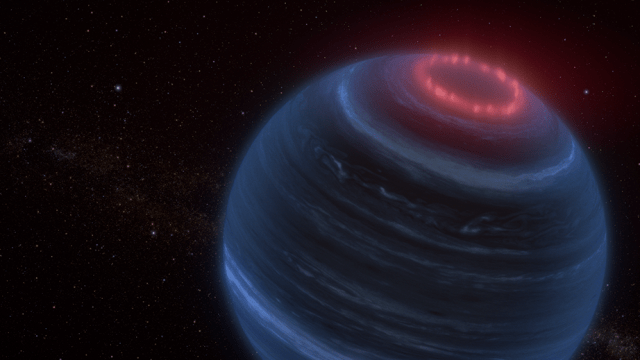The Webb Space Telescope has spotted something weird: a brown dwarf with what appear to be aurorae, what we Earthlings sometimes call the Northern Lights. What makes the observation particularly surprising is that the brown dwarf doesn’t have a nearby star that could cause such an aurora.
Aurorae on Earth happens when particles from the Sun interact with gasses in our planet’s atmosphere, along the lines of Earth’s magnetic field. Other planets in our solar system sport aurorae; Webb imaged luminous aurorae on Jupiter’s poles in 2022, and astronomers using the Keck II Telescope’s Near-Infrared Spectrograph (NIRSPEC) imaged an aurora on Uranus last October.
But brown dwarfs are not planets. They are objects that are dozens of times more massive than Jupiter (our solar system’s largest planet) but smaller than stars. And unlike stars, as EarthSky explains, brown dwarfs do not undergo normal stellar fusion. In that way, brown dwarfs are failed stars, though they can still be thousands of degrees hotter than the Sun. But not always: the recently observed brown dwarf (named W1935) is pretty cold, only about 400 degrees Fahrenheit (200 degrees Celsius), and doesn’t have a star to cascade particles its way. Aurorae have been observed around brown dwarf-like objects before, but this brown dwarf has no known star that could power the light shows.
In research being presented at the 243rd meeting of the American Astronomical Society, which concludes tomorrow, a group of scientists unpack the auroral mystery. Jackie Faherty, an astronomer at the American Museum of Natural History in New York, led the team. The group investigated 12 cold brown dwarfs with Webb and found two of them to have similar compositions, temperatures, and spectra. But one of the dwarfs—W1935—exhibited a methane emission.
“We expected to see methane because methane is all over these brown dwarfs,” Faherty said in a Space Telescope Science Institute release. “But instead of absorbing light, we saw just the opposite: The methane was glowing. My first thought was, what the heck? Why is methane emission coming out of this object?”
The team’s models indicated that W2220, the similar brown dwarf, got cooler at higher altitudes. But W1935 got hotter at higher altitudes, according to their model. “We have seen this kind of phenomenon in planets with a nearby star that can heat the stratosphere, but seeing it in an object with no obvious external heat source is wild,” said co-author Ben Burningham, an astrophysicist at the University of Hertfordshire and who led the modelling work, in the STScI release.
The higher energies at higher altitudes suggested to the team that W1935 has aurorae, making it the coldest candidate for hosting aurora outside the solar system. They hope that the Webb spectral data can help explain what causes the methane emission. For now, W1935 showcases the diversity of our universe—and plenty more superlative objects lie in wait for our discovery.
